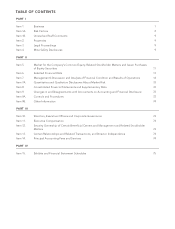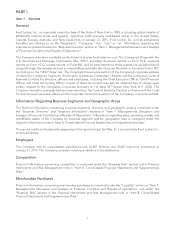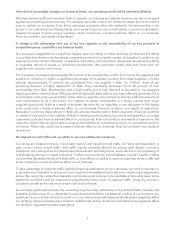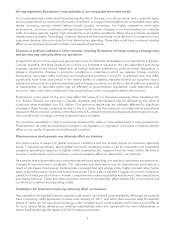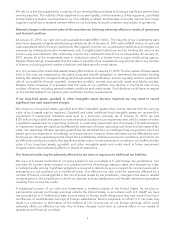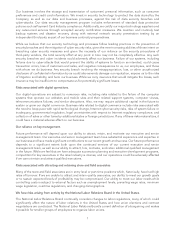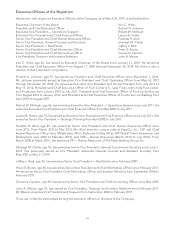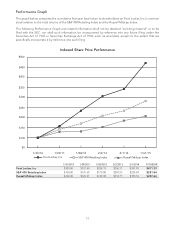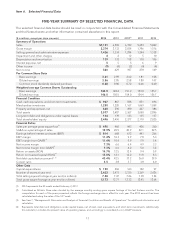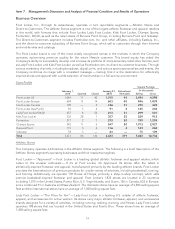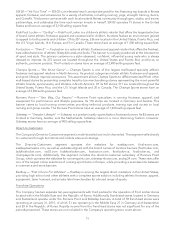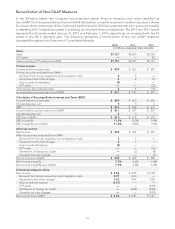Foot Locker 2014 Annual Report Download - page 30
Download and view the complete annual report
Please find page 30 of the 2014 Foot Locker annual report below. You can navigate through the pages in the report by either clicking on the pages listed below, or by using the keyword search tool below to find specific information within the annual report.Our business involves the storage and transmission of customers’ personal information, such as consumer
preferences and credit card information. We invest in security technology to protect the data stored by the
Company, as well as our data and business processes, against the risk of data security breaches and
cyber-attacks. Our data security management program includes enforcement of standard data protection
policies such as Payment Card Industry compliance. Additionally, we certify our major technology suppliers and
any outsourced services through accepted security certification measures. We maintain and routinely test
backup systems and disaster recovery, along with external network security penetration testing by an
independent third party as part of our business continuity preparedness.
While we believe that our security technology and processes follow leading practices in the prevention of
security breaches and the mitigation of cyber security risks, given the ever-increasing abilities of those intent on
breaching cyber security measures and given the necessity of our reliance on the security procedures of
third-party vendors, the total security effort at any point in time may not be completely effective. Any such
security breaches and cyber incidents could adversely affect our business. Failure of our systems, including
failures due to cyber-attacks that would prevent the ability of systems to function as intended, could cause
transaction errors, loss of customers and sales, and negative consequences to us, our employees, and those
with whom we do business. Any security breach involving the misappropriation, loss, or other unauthorized
disclosure of confidential information by us could also severely damage our reputation, expose us to the risks
of litigation and liability, and harm our business. While we carry insurance that would mitigate the losses, such
insurance may be insufficient to compensate us for potentially significant losses.
Risks associated with digital operations.
Our digital operations are subject to numerous risks, including risks related to the failure of the computer
systems that operate our websites and mobile sites and their related support systems, computer viruses,
telecommunications failures, and similar disruptions. Also, we may require additional capital in the future to
sustain or grow our digital commerce. Business risks related to digital commerce include risks associated with
the need to keep pace with rapid technological change, Internet cyber security risks, risks of system failure or
inadequacy, governmental regulation, legal uncertainties with respect to Internet regulatory compliance, and
collection of sales or other taxes by additional states or foreign jurisdictions. If any of these risks materializes, it
could have a material adverse effect on our business.
Our reliance on key management.
Future performance will depend upon our ability to attract, retain, and motivate our executive and senior
management team. Our executive and senior management team have substantial experience and expertise in
our business and have made significant contributions to our recent growth and success. Our future performance
depends to a significant extent both upon the continued services of our current executive and senior
management team, as well as our ability to attract, hire, motivate, and retain additional qualified management
in the future. While we feel that we have adequate succession planning and executive development programs,
competition for key executives in the retail industry is intense, and our operations could be adversely affected
if we cannot retain and attract qualified executives.
Risks associated with attracting and retaining store and field associates.
Many of the store and field associates are in entry level or part-time positions which, historically, have had high
rates of turnover. If we are unable to attract and retain quality associates, our ability to meet our growth goals
or to sustain expected levels of profitability may be compromised. Our ability to meet our labor needs while
controlling costs is subject to external factors such as unemployment levels, prevailing wage rates, minimum
wage legislation, overtime regulations, and changing demographics.
We face risks arising from activity by the National Labor Relations Board in the United States.
The National Labor Relations Board continually considers changes to labor regulations, many of which could
significantly affect the nature of labor relations in the United States and how union elections and contract
negotiations are conducted. The National Labor Relations Board’s current definition of a bargaining unit makes
it possible for smaller groups of employees to organize labor unions.
7





